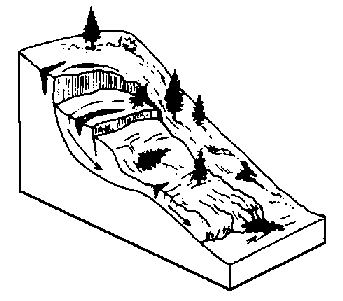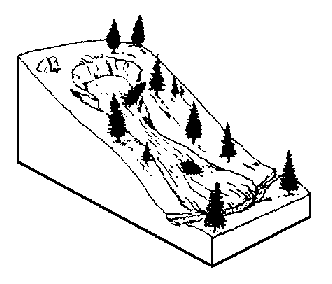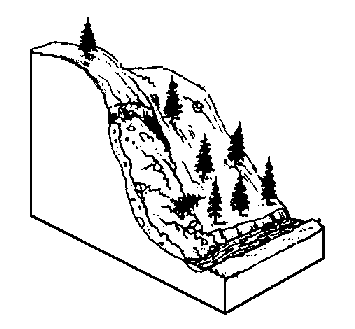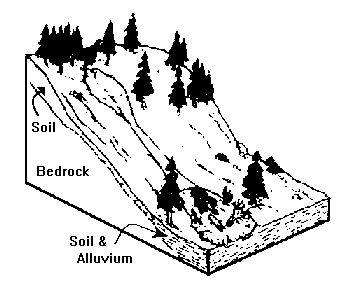
Diagrammatic sketch of a translational/rotational landslide by Janet Appleby,
Richard Kilbourne, and Thomas Spittler; modified from Varnes (1978)
Types of Mass Wasting
Reference: Dept of Conservation, State of California
DMG Note 50 Definition.
Translational/Rotational Landslide
This kind of slide is characterized by large blocks of material and a failure
plane that is relatively deep. The movement is forms straight or almost straight lines
downhill. It occurs in relatively cohesive, homogeneous soils and rock. The soil mantle
may be greater than 5 feet thick, but sliding is not restricted to the zone of weathering.
Failure commonly occurs along bedrock bedding planes that are deep-seated and dip in the
same direction as the slope surface. In saturated conditions, incompetent clayey bedrock
material may fail under overburden weight and high pore pressures, resulting in a
deep-seated rotational-type failure. Translational slides commonly are controlled
structurally by surfaces of weakness such as faults, joints, bedding planes, and contacts
between bedrock and overlying deposits.
Translational/rotational slides generally form a concentric (like) near
vertical scarp in the head region and, occasionally, along the lateral margins of the
slide. Slide materials are characterized by hummocky topography consisting of rolling,
bumpy ground, frequent benches, and depressions. The toe of the slide may be steep where
slide material has accumulated. Steep crownscarps and margins of the
translational/rotational slide and toe areas of large slides may be subject to debris
sliding.

Diagrammatic sketch of a translational/rotational landslide by Janet Appleby,
Richard Kilbourne, and Thomas Spittler; modified from Varnes (1978)
Earthflow
An earthflow is a landslide resulting from slow to rapid
movement of saturated soil and debris in a liquidy state. After initial failure, the
earthflow may move, or creep, seasonally in response to destabilizing forces. Earthflows
are composed of clay-rich materials that swell when wet, causing a reduction in friction
between the soil particles. When saturated, the fine-grained, clay-rich matrix may carry
larger, more resistant boulders with them in slow, creeping movements. Slide materials
erode easily, resulting in gullying and irregular drainage patterns. The irregular,
hummocky ground characteristic of earthflows is generally bare of trees. Failures commonly
occur on slopes that are gentle to moderate, although they may also occur on steeper
slopes where vegetation has been removed. Undercutting of the toe of an earthflow is
likely to reactivate downslope movement.

Diagrammatic sketch of an earthflow by Janet Appleby
and Richard Kilbourne; modified from Varnes (1978)
Debris Slide
A debris slide is characterized by unconsolidated rock and
soil that has moved downslope along a relatively shallow failure plane. Debris slides form
steep, unvegetated scars (depressions) in the head region and irregular, hummocky deposits
(when present) in the toe region. Debris slide scars are likely to ravel and remain
unvegetated for many years. These scars can be recognized by the nature of the slope,
steepness of the slope, and the light bulb-shaped form left by many mid- and upper-slope
failures.
Debris slides are most likely to occur on slopes greater than 65
percent where unconsolidated colluvium overlie a shallow soil/bedrock. The shallow slide
surface is usually less than 15 feet deep. The probability of sliding is low where bedrock
is exposed, except, where weak bedding planes and extensive bedrock joints and fractures
parallel the slope.

Diagrammatic sketch of a debris slide by Janet Appleby
and Richard Kilbourne; modified from Varnes (1978).
Debris Flow/Torrent Track
Debris flow and debris torrent tracks are characterized by
long stretches of bare, generally unstable stream channel banks that have been scoured and
eroded by the extremely rapid movement of water-laden debris. They commonly are caused by
debris sliding or the failure of fill materials along stream crossings in the upper part
of a drainage during high intensity storms.
Debris flow/torrent tracks are formed by the failure of water-charged
soil and organic material down steep stream channels. They are often triggered by debris
slide movement on adjacent hill slopes and by the mobilization of debris accumulated in
the stream channels themselves. Debris flows and torrents commonly entrain large
quantities of inorganic and organic material from the stream bed and banks. Occasionally,
the channel may be scoured to bedrock. When momentum is lost, scoured debris may be
deposited as a tangled mass of large organic debris in a matrix of sediment and finer
organic material. Such debris may be reactivated or washed away during subsequent events.
The erosion of steep debris slide-prone streambanks below the initial failure may caused
further failure downstream.

Diagrammatic sketch of a debris flow/torrent
track.by Janet Appleby and Richard Kilbourne.
For a look at landslides, earthflow, debris slide and debris flow, check out the Landslide Photos